Shirt-Pocket Movie Camera
Shirt-Pocket Sound Movie Camera
Smaller and lighter than any other sound or silent 8mm movie camera.
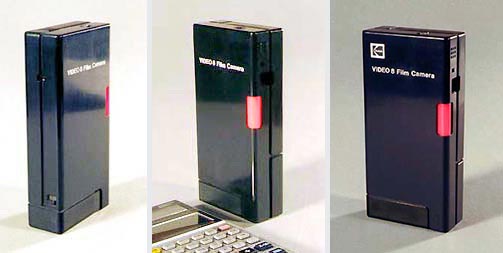
A silent-running, shirt-pocket sound movie camera developed by Steve Hines at the Kodak Research Laboratories in 1976. The design goal was to develop an automatic, pocketable movie camera to encourage filmmaking.
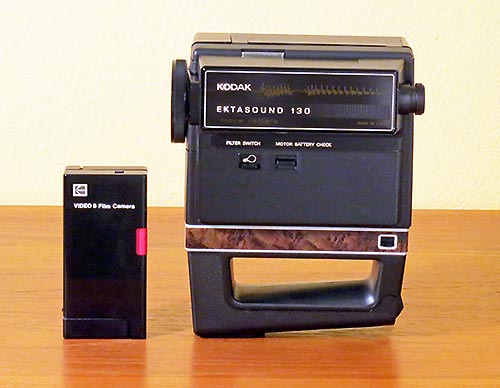
The 5-oz. Shirt-Pocket Sound Movie Camera beside the 3-lb. Kodak Ektasound 130.
The smallest 8mm movie cameras available in 1976:
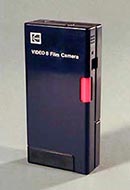 |
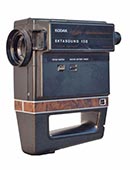 |
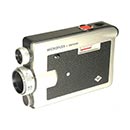 |
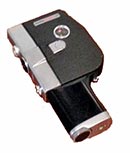 |
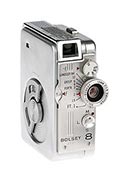 |
|
| Kodak pocket experimental | Kodak Ektasound 130 | Agfa Microflex Sensor | Fujica P1 | Bolsey 8 | |
| Film format | frame size of Super 8 | Super 8 sound | Super 8 | Single 8 |
Standard 8 magazine |
| Run time- min. | 3-1/3 | 3-1/3 | 3-1/3 | 3-1/3 | 2 |
| Frame rate | 15 fps | 18 fps | 18 fps | 18 fps |
16 fps |
| Shutter angle | 360° | 230° | 180° | 160° | ≈ 150° |
| Duty cycle | 100% | 63% | 50% | 44% | ≈ 42% |
| Weight, grams | 142 | 1250 | 500 | 530 | 400 |
| Volume, cu. in. | 10.4 | 180 | 31.5 | 31.5 | 11.1 |
| Camera operating noise | virtually silent, similar to a tape recorder | usual chatter of intermittent film pull down | usual chatter of intermittent film pull down | usual chatter of intermittent film pull down | usual chatter of intermittent film pull down |
| Microphone | built in | external | — | — | — |
This shirt pocket camera does not use the typical blocking shutter. When taking a shot, the camera is always exposing frames. An optical differential causes the image to chase continuously moving film, giving the equivalent of a 360° shutter.
The pocket camera uses 8mm wide, mag-striped film, almost as thin and flexible as audio tape. Instead of the film using perforations, the camera exposes optical fiducial marks beside each frame, used later by the projector to register the film.
The concept for this continuous-motion camera was first tested by building a Super 8 projector with the identical optical differential. In spite of the relatively low 15-fps frame rate the image does not flicker because there is no rotating shutter to block light. For the first time, viewers can watch movies without the noise of the projector (or camera) intermittent film pull down. The only sound is from the movie sound track. The sound-recording head is at the film gate. If the film is edited, there is no time gap between the picture and sound. The pocket camera was developed from clean paper to working prototype in 9 months.
Movies from the camera are viewed on a television using a Kodak VP-1 or VP-X video film player, therefore the use of “Video” in the original name. Conceived as a consumer camera, however the small size and near-silent film movement makes it useful as a covert spy camera.
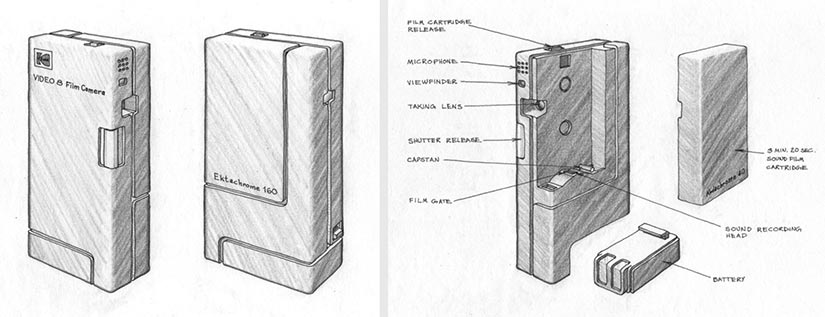
- The size is minimized by attaching the film cartridge and battery to the outside of the camera to complete the form, rather than inserting them inside a larger camera. The quiet-running film transport allows the microphone to be built in.
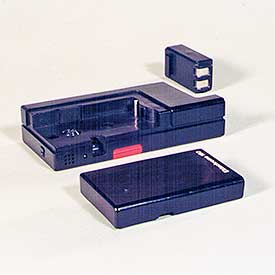 |
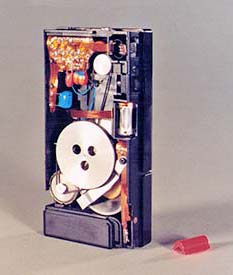 |
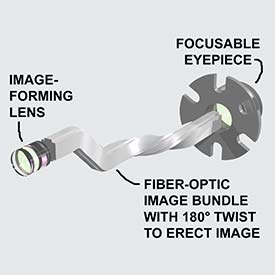 |
| The pocket movie camera with film cartridge and battery removed, showing capstan drive, film take-up toothed drive, taking lens, shutter release, viewfinder opening, viewfinder focus, film gate, and sound-recording head. | The battery, shutter-release, flywheel, taking lens, optical differential, motor, speed regulator, fiber-optic viewfinder, microphone, and sound amplifier on folded flex circuit. | The fiber-optic viewfinder, twisted 180° to create erect image for the eyepiece, shifted vertically and laterally to clear other components in the camera and to place the eyepiece on center of the camera. |
Technical Specifications:
Size: fits in a shirt pocket.
- Weight: 5 oz. (142 grams).
- Sound: Built-in microphone, automatic gain control.
- Taking Lens: 10mm FL, ƒ3.5.
- Film load: 3-1/3 min.
- Frame rate: 15 fps.
- Film type: un-perforated, 8mm mag-striped, thin base, capstan driven.
- The film being unperforated, reduces cost.
- Shutter angle: 360°.
- Exposure: automatic.
- Viewfinder: fiber-optic image bundle.
- Eyepiece: focusable.
- Film type and ASA: keyed to camera by film cartridge.
- Operating noise level: similar to a pocket cassette recorder (nearly silent).
In comparison to today’s digital smartphone cameras, this pocket movie camera may not seem that small; however, to put this in the context of 1976, this camera was developed when:
- TV news was shot on 16mm B/W film.
- 5 years before the IBM PC.
- 6 years before music CD’s.
- 8 years before the first 8mm camcorder.
- 19 years before GPS navigation in cars.
- 31 years before the iPhone.
Comments:
“I was very impressed by the ingenuity that went into this device… So many clever ideas in such a small package! My hat is off to you.”, Andy Baird, Oct. 3, 2019
During the 9 months of the pocket camera’s development, competing B/W video cameras and shoulder-strap reel-reel recorders were coming to the market. As a further hurdle, the pocket camera required a new film format, new projectors or video film players, etc. Interest in video had become too strong to create this new film format.
Once Kodak business confidential, this technology by agreement between Eastman Kodak and HinesLab is available for license from HinesLab. It also serves as an example of technology which can be developed for clients of HinesLab on a contract basis. For any questions, please contact Steve Hines at:
USA
email: Steve@HinesLab.com
Phone: 818-507-5812
